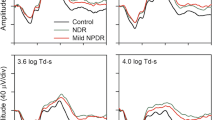Abstract
There is ample evidence that the retinal pigment epithelium (RPE) is affected in diabetes, and that epitheliopathy may be among the early changes. The fast oscillation (FO) of the electro-oculogram (EOG) reflects the activity of the RPE, most notably the mechanisms responsible for pumping fluid and ions in the retina-to-choroid direction. The FO was measured in three groups of subjects: normal controls, eyes of diabetic individuals with no evidence of retinopathy, and eyes of diabetics with mild background retinopathy. FO amplitude, light trough voltage and dark peak voltage in both diabetic groups were all significantly reduced, independent of retinopathy status. The peak to trough ratio was unaffected. These changes, reduced voltages and smaller light-evoked voltage changes, are consistent with a decrease in the resistance of the RPE and may relate to accumulation of fluid in the sub-retinal space.


Similar content being viewed by others
References
Grimes PA, Laties AM (1980) Early morphological alteration of the pigment epithelium in streptozotocin-induced diabetes: increased surface area of the basal cell membrane. Exp Eye Res 30:631–639
Tso MO, Cunha-Vaz JG, Sjih CY, Jones CW (1980) Clinicopathologic study of blood-retinal barrier in experimental diabetes mellitus. Arch Ophthalmol 98:2032–2040
Blair NP, Tso MO, Dosge JT (1984) Pathologic studies of the blood-retinal barrier in the spontaneously diabetic rat. Invest Ophthalmol Vis Sci 25:302–311
MacGregor LC, Matschinsky FM (1986) Experimental diabetes mellitus impairs the function of the retinal pigmented epithelium. Metabolism 35:28–34
Chakrabati S, Prashar S, Sima AA (1990) Augmented polyol pathway activity and retinal pigment epithelial permeability in the diabetic BB rat. Diabetes Res Clin Pract 8:1–11
Vinores SA, Van Niel E, Swerdloff JL, Campochiaro PA (1993) Electron microscopic immunocytochemical demonstration of blood-retinal barrier breakdown in human diabetics and its association with aldose reductase in retinal vascular endothelium and retinal pigment epithelium. Histochem J 9:648–663
Weinberger D, Fink-Cohen S, Gaton DD, Priel E, Yassur Y (1995) Non-vascular leakage in diabetic maculopathy. Br J Ophthalmol 79:728–731
Vinores SA, Derevjanik NL, Ozaki H, Okamoto N, Campochiaro PA (1999) Cellular mechanisms of blood-retinal barrier dysfunction in macular edema. Doc Ophthalmol 97:217–228
Aizu Y, Oyanagi K, Hu J, Nakagawa H (2002) Degeneration of retinal neuronal processes and pigment epithelium in the early stage of the streptozotocin-diabetic rats. Neuropathology 22:161–170
Steinberg RH (1985) Interactions between the retinal pigment epithelium and the neural retina. Doc Ophthalmol 60:327–346
Gallemore RP, Steinberg RH (1993) Light-evoked modulation of basolateral membrane Cl- conductance in chick retinal pigment epithelium: the light peak and fast oscillation. J Neurophysiol 70:1669–1680
Blaug S, Quinn R, Quong J, Jalickee S, Miller SS (2003) Retinal pigment epithelial function: a role for CFTR? Doc Ophthalmol 106:43–50
Marmor MF (1999) Mechanisms of fluid accumulation in retinal edema. Doc Ophthalmol 97:239–249
Arden GB, Kelsey J (1962) Changes produced by light in the standing potential of the human eye. J Physiol 161:189–204
Arden GB, Barrada A (1962) An analysis of electro-oculograms of a series of normal subjects. Br J Ophthalmol 46:468–482
Kolder H, Brecher GA (1966) Fast oscillations of the corneretinal potential in man. Arch Ophthalmol 75:232–237
Arden GB, Constable PA (2006) The electro-oculogram. Prog Retin Eye Res 25:207–248
Weleber RG (1989) Fast and slow oscillations of the electro-oculogram in Best’s Macular dystrophy and retinitis pigmentosa. Arch Ophthalmol 107:530–537
Bialek S, Joseph DP, Miller SS (1998) The delayed basolateral membrane hyperpolarization of the bovine retinal pigment epithelium: mechanism of generation. Journal of Physiology 484(Pt1):53–67
Linsenmeier RA, Steinberg RH (1984) Delayed basal hyperpolarization of cat retinal pigment epithelium and its relation to the fast oscillation of the DC electroretinogram. J Gen Physiol 83:213–232
Mergaerts F, Daems E, van Malderen L, Spileers W (2001) Recording of the fast oscillations in the human electro-oculogram. Doc Ophthalmol 103:63–72
Alessandrini M, Bruno E, Parisi V, Uccioli L, Giacomini PG (2001) Saccadic eye movement, visual pathways function in diabetic patients. An Otorrinolaringol Ibero Am 28:269–280
Alessandrini M, Paris V, Bruno E, Giacomini PG (1999) Impaired saccadic eye movement in diabetic patients: the relationship with visual pathways function. Doc Ophthalmol 99(1):11–20
Huber MJ, Smith SA, Smith SE (1985) Mydriatic drugs for diabetic patients. Br J Ophthalmol 69:425–427
Lopez P, Reuter LM, Caruso R (2007) The effect of aging on the normal electrooculogram 2007. Presented at ARVO. Program # 3706
Holopigian K, Greenstein VC, Seiple W, Hood DC, Carr RE (1997) Evidence for photoreceptor changes in patients with diabetic retinopathy. Invest Ophthalmol Vis Sci 38:2355–2365
Shirao Y, Kawasaki K (1998) Electrical responses from diabetic retina. Prog Retin Eye Res 17:59–76
Arden GB, Wolf JE, Singbartl F, Berninger TE, Rudolph G, Kampik A (2000) Effect of alcohol and light on the retinal pigment epithelium of normal subjects and patients with retinal dystrophies. Br J Ophthalmol 84:881–883
Wu KH, Marmor MF (2005) Alcohol- and light-induced electro-oculographic responses in age-related macular degeneration & central serous chorioretinopathy. Doc Ophthalmol 110:237–246
Acknowledgments
Supported by National Eye Institutes grant EY02271 to AJA.
Author information
Authors and Affiliations
Corresponding author
Additional information
Portions of these findings were presented at ARVO, 2001.
Rights and permissions
About this article
Cite this article
Schneck, M.E., Shupenko, L. & Adams, A.J. The fast oscillation of the EOG in diabetes with and without mild retinopathy. Doc Ophthalmol 116, 231–236 (2008). https://doi.org/10.1007/s10633-007-9088-3
Received:
Accepted:
Published:
Issue Date:
DOI: https://doi.org/10.1007/s10633-007-9088-3




